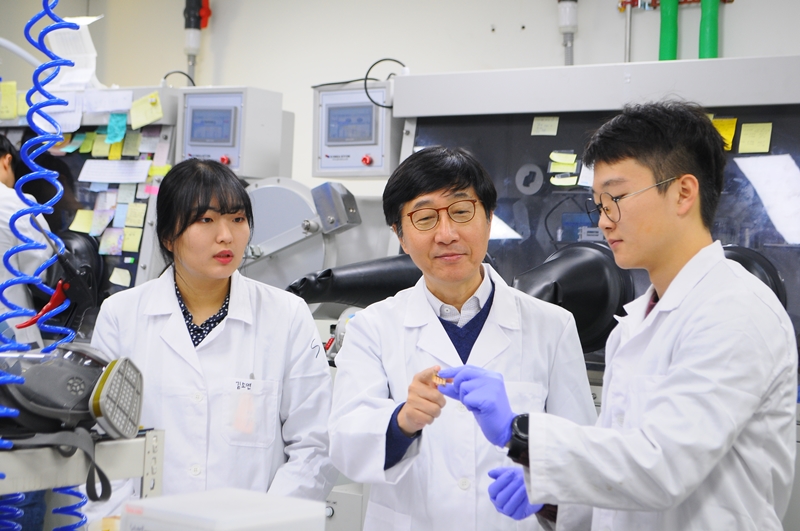
Sungkyunkwan University professor Park Nam-Gyu (second from right) and his team research the functions of the next-generation perovskite solar cells. (Ministry of Science and ICT)
By Koh Hyunjeong
As humanity faces grave challenges stemming from the climate crisis and strives for carbon neutrality, interest is growing in developing renewable energy that does not emit greenhouse gases. Among such power sources, solar is gaining ground as an innovative option with high potential.
The first generation of silicon solar cells was developed in 1954 at Bell Laboratories in the U.S. They have since evolved to the second generation of thin-film cells and keep evolving.
The advances in the photoconversion efficiency of such cells with the mineral perovskite have been amazing. The first generation of silicon cells took 50 years to reach 25% efficiency of converting light into electricity, but the perovskite models took just 10.
Behind this breakthrough were the passion and efforts of Korean scientists.
Park Nam-Gyu, a professor at Sungkyunkwan University in Seoul, developed in 2012 the world's first solid-state perovskite solar cells. The mineral tended to dissolve in liquid solvent, making it deemed inadequate for solar cells, but Park replaced liquid electrolytes with solid organic material to raise the photoconversion efficiency to 9.7%.
This innovation fundamentally changed the solar cell technological system.
In May last year, the results of his research were highlighted at the Nobel Symposium hosted by the Royal Swedish Academy of Sciences. For his work, Park in July this year received the Top Scientist and Technologist Award of Korea, the nation's highest honor for science and technology.
Over 90% of solar power installations for commercial use are first-generation silicon-based solar cells, which have high production costs but are sturdy and boast high photoconductivity. Yet expensive equipment is necessary to melt polysilicon and ingots in a furnace at over 1,000 degrees Celsius.
The expenses for perovskite solar cells, however, are considerably lower. The processing temperature is around 100 degrees Celsius, enabling lightweight and flexible material.
"Perovskite's theoretical efficiency rate is 30%," Park said. "We're conducting research on new materials, process and elements to further improve on the current level of technology."
His team is studying the structure in which perovskite best absorbs light and conducts electricity, adding, "We're striving to enhance long-term safety, as solar cells must be usable for decades."
Park said his sights are now set on development of platform materials meeting the demands of society, something that he said requires extensive basic knowledge and numerous experiments.
"In-depth basic knowledge is important, but broad knowledge is also very important to see what you know," he said, referring to the need for wide knowledge of a field to cover it in depth.
hjkoh@korea.kr
Most popular
- 2 Egyptian sisters reflect on 10 years as Honorary Reporters
- Korea Welcome Week for foreign tourists set from April 25-May 16
- Korea.net welcomes 2025 K-influencers, Honorary Reporters
- Actor Bae Doona's first romcom in decade to hit theaters in May
- 2025 Honorary Reporter class pledges to spread 'real Korea' worldwide
